 |
|
São Paulo/Congonhas Airport
Aeroporto de São Paulo/Congonhas |
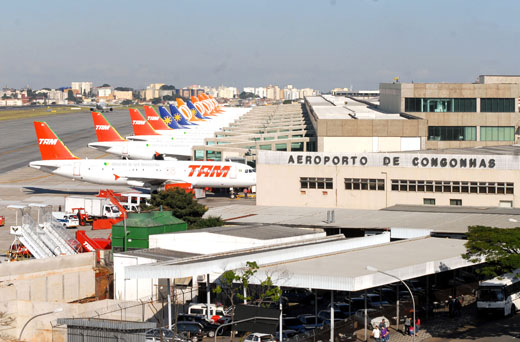 |
| IATA: CGH – ICAO: SBSP |
| Summary |
| Airport type |
Public |
| Operator |
Infraero |
| Serves |
São Paulo |
| Elevation AMSL |
802 m / 2,631 ft |
| Coordinates |
23°37′40″S 46°39′15″W / 23.62778°S 46.65417°W / -23.62778; -46.65417 |
| Website |
Infraero CGH |
| Runways |
| Direction |
Length |
Surface |
| m |
ft |
| 17R/35L |
1,940 |
6,365 |
Asphalt |
| 17L/35R |
1,435 |
4,708 |
Asphalt |
| Statistics (2009) |
| Passengers |
13,699,657 |
| Aircraft Operations |
193,308 |
| Metric tonnes of cargo |
29,306 |
Statistics: Infraero
Sources: Airport Website |
Congonhas/São Paulo Airport or Congonhas Airport (IATA: CGH, ICAO: SBSP) is one of São Paulo's three commercial airports, situated 8 kilometers (5 miles) from the city center at Washington Luís Avenue, in Campo Belo district. It is owned by the City of São Paulo and managed by Infraero. In 2009, it was the 2nd busiest airport in Brazil both in terms of passenger traffic and aircraft movements, handling 193,308 aircraft movements and 13,699,657 passengers.
Congonhas currently operates with slot restrictions of a maximum of 30 operations/hour, being one of the two airports with such restrictions in Brazil. History
The airport's name came from a plant that used to be common in the area where the airport was built. The airport was initially planned in 1919, but it did not open until September 12, 1936. At that time, it was the private airport of VASP, built as an alternative to Campo de Marte, which, already at that time, had operational difficulties. By 1957, the airport was the third busiest in the world for cargo and freight. The passenger terminal's central hall is considered one of the most outstanding examples of modern architecture in São Paulo. However, modernizing and enlargement works conducted at the terminal from 2003 onwards, while trying to preserve the look of the older, historic section, still made the latter lose much of its former character.
Congonhas Airport is the main hub of Brazil's largest airlines: TAM and Gol.
Importance to the city
 | |
The classic but highly modified modern-architecture Congonhas Airport terminal central hall |
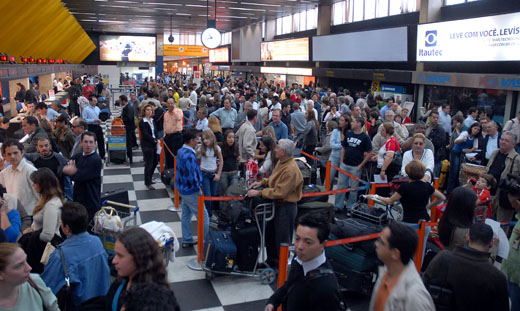 | |
Queues at Congonhas Airport |
Congonhas was São Paulo's main airport until 1985, when São Paulo-Guarulhos International Airport was built because of congestion at Congonhas and because the latter's short runways could not handle the large aircraft required for long-haul flights.
In spite of that, Congonhas Airport continues to be important to the city for regional and short-distance domestic flights. Given the concentration of Brazil's economy in the Central-Southern region, where São Paulo is located, such flights make up the greatest share of the country's domestic air traffic. Therefore, even after Guarulhos International Airport was opened, Congonhas continued to face congestion problems (and still does), regarding both the number of passengers and the number of flight operations. In spite of continuing modernization works, it is a small and outdated airport for today's standards, and its relatively short runways cannot be extended because of the sheer urban growth of São Paulo, which has completely surrounded and engulfed the airport.
Indeed, the view from the landing approach to Congonhas can be spectacular, with the airplane flying very low over massive clusters of tall skyscrapers, especially when the plane approaches from the north. It is the short distance from downtown and from the major business areas of Paulista, Faria Lima and Luís Carlos Berrini avenues that still makes Congonhas a favorite of passengers, especially business travelers, much in the same way as Ronald Reagan National Airport next to Washington, D.C. and LaGuardia Airport in New York.
Former international operations
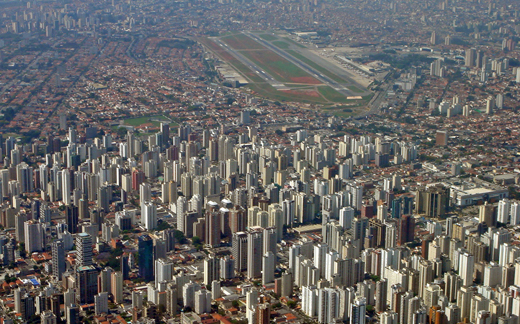 | |
Aerial view. |
Until the 1980s, Congonhas Airport operated direct international flights to neighbouring countries such as Argentina, Uruguay, Paraguay and Bolivia, as well as intercontinental flights changing planes at Rio de Janeiro-Galeão International Airport. However, since the opening of Guarulhos Airport, international flights are no longer operated (or even allowed) at Congonhas.
With a much longer runway and better weather conditions, Viracopos International Airport was (at least in theory) the main international airport serving São Paulo until 1985, but in practice its very distant location in Campinas, 100 km (62 miles) from downtown São Paulo, made it very inconvenient for passengers and airlines – so much that most international passengers preferred to board instead a flight from Congonhas Airport to Rio de Janeiro-Galeão (or vice versa), connecting with their international flights there. At that time, Viracopos even appeared on the Guinness Book of Records as the farthest airport from the city it allegedly served, a dubious title that now probably rests with Stockholm-Västerås Airport, a secondary airport serving (at least nominally) Stockholm, Sweden, located about 110 km (68 miles) from that city.
Today, Guarulhos Airport handles all international passenger traffic to and from São Paulo, but Viracopos remains the second busiest Brazilian airport for cargo operations, both domestic and international. It also has some domestic passenger traffic, catering to the local market of the prosperous Campinas region.
Safety concerns
 | |
Workers adding grooves to the main runway at Congonhas Airport in 2007 |
The airport has been troubled by slippery runways and has had several accidents where water accumulation has been a significant factor (most notably, the one involving TAM Brazilian Airlines Flight 3054 in July 2007). Although the main runway was repaved in June 2007, its new rainwater drainage grooves were only finished in September 2007. The approach path over densely populated areas causes noise and raises further safety concerns.
The largest aircraft now operating at Congonhas are the Boeing 737-800 (Gol) and the Airbus A320 (TAM). However, in the past the airport used to have operations with Boeing 767 and Airbus A300 wide-body aircraft, by the now-defunct airlines Transbrasil, VASP and Cruzeiro.
In consequence of the TAM 3054 accident, and with the subsequent public outcry for more safety, the airport has had its operations significantly altered, through the reduction of landing slots and restrictions on flight distance and connections. This has reduced the maximum allowable gross weight of landing aircraft, increasing safety margins. To compensate for the traffic, there are talks of a third commercial airport to be built in a yet-undecided location in São Paulo, but experts heard by the Brazilian press say that the actual construction of such an airport is unlikely, and that an enlargement of Guarulhos Airport, coupled with improvement in the access to that farther airport, is much more likely and feasible.
General information
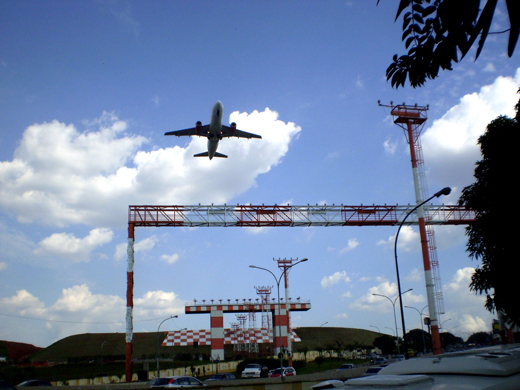 | |
TAM Airbus A320 taking off from Congonhas |
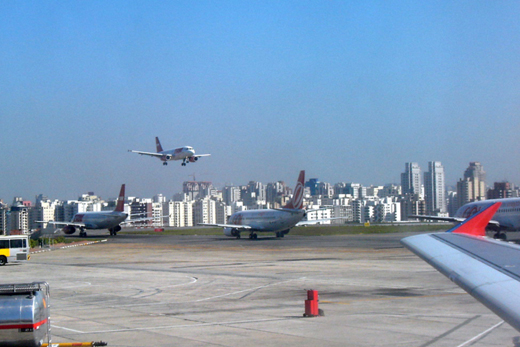 | |
Airplanes waiting in line for take off at the congested Congonhas Airport. |
- Main Terminal: 51,535 m (554,718 sq.ft.)
- Main destinations: Rio de Janeiro (flights on average every 15 min), Belo Horizonte, Brasília and Curitiba (flights on average every 25-30 min to each destination).
Airlines and destinations
| Airlines |
Destinations |
| Avianca Brazil |
Belo Horizonte-Confins, Brasília, Florianópolis, Rio de Janeiro-Santos Dumont |
| Azul Brazilian Airlines |
Porto Seguro |
| Gol Airlines |
Bauru-Arealva, Belo Horizonte-Confins, Belo Horizonte-Pampulha, Brasília, Campo Grande, Caxias do Sul, Cuiabá, Florianópolis, Goiânia, Joinville, Londrina, Maringá, Navegantes, Porto Alegre, Presidente Prudente, Rio de Janeiro-Santos Dumont, Salvador da Bahia, Uberlândia, Vitória |
| NHT Linhas Aéreas |
Campinas-Viracopos, Curitiba-Afonso Pena, Florianópolis, Navegantes |
| TAM Airlines |
Belo Horizonte-Confins, Brasília, Cabo Frio, Campo Grande, Curitiba-Afonso Pena, Florianópolis, Goiânia, Joinville, Londrina, Navegantes, Porto Alegre, Ribeirão Preto, Recife, Salvador da Bahia, São José do Rio Preto, Rio de Janeiro-Galeão, Rio de Janeiro-Santos Dumont, Uberlândia, Vitória |
| TAM Airlines operated by Pantanal Linhas Aéreas |
Bauru-Arealva, Brasília, Belo Horizonte-Confins, Cuiabá, Curitiba-Afonso Pena, Porto Alegre, Ribeirão Preto, Rio de Janeiro-Galeão, Salvador da Bahia |
| Webjet |
Porto Alegre, Porto Seguro, Rio de Janeiro-Santos Dumont |
a.^ Regular charter destination only.
Accidents and incidents
Accidents with fatalities
- 27 August 1943: VASP, a Junkers Ju-52/3mg3e registration PP-SPD, flying from Rio de Janeiro-Santos Dumont to Congonhas airport struck a building of the Naval Academy located close to the airport shortly after take-off under fog. The aircraft broke in two and one part fell in the water. Of the 21 passengers and crew, 3 survived.
- 31 August 1944: Panair do Brasil, a Lockheed Model 18 Lodestar registration PP-PBI crashed while on night approach to Congonhas Airport. All 18 occupants died.
- 13 March 1948: Cruzeiro do Sul, a Douglas C-53D-DO registration PP-CBX flying to Congonhas Airport crashed on Cantareira Range, near São Paulo. All 6 passengers and crew aboard died.
- 2 August 1949: Varig, a Curtiss C-46AD-10-CU Commando registration PP-VBI operating a flight from São Paulo-Congonhas Airport to Porto Alegre made an emergency landing on rough terrain near the location of Jaquirana, approximatelly 20 minutes before landing in Porto Alegre, following fire on the cargo hold. Of the 36 passenger and crew aboard, 5 died.
- 13 May 1952: VASP, a Douglas C-47B-45-DK registration PP-SPM operating a flight from São Paulo-Congonhas Airport to Bauru Airport lost control when carrying out an emergency landing following an engine failure. Two crew members and 3 passengers died.
- 17 June 1953: Panair do Brasil, a Lockheed L-049 Constellation registration PP-PDA crashed on final approach to Congonhas Airport. Apparently causes are related to night operations with little visibility. All 17 passengers and crew died.
- 4 June 1954: Varig, a Curtiss C-46A-45-CU Commando registration PP-VBZ operating a cargo flight between Congonhas Airport and Porto Alegre crashed during take-off from São Paulo. All crew of 3 died.
- 10 April 1957: Transportes Aéreos Nacional operated by Real Transportes Aéreos, a Douglas DC-3/C-47 registration PP-ANX, en route from Rio de Janeiro-Santos Dumont to Congonhas Airport, crashed into a mountain over the location of Ubatuba. The no. 2 engine caught fire, which forced the crew to make an emergency descent for Ubatuba. Due to rain, the crew noticed Papagaio Peak on Anchieta Island too late. The aircraft stalled during the evasive manoeuvre and crashed into the mountain. Of the 30 passengers and crew aboard, 26 died.
- 30 December 1958: VASP, a Saab Scandia 90A-1 registration PP-SQE flying from Rio de Janeiro-Santos Dumont to Congonhas Airport, during climb after take-off had a failure on engine no. 1. The pilot initiated procedures to return to the airport but during the second turn the aircraft stalled and crashed into Guanabara Bay. Of the 37 passengers and crew aboard, 21 died.
- 26 November 1962: VASP, a Saab Scandia 90A-1 registration PP-SRA, en route from Congonhas Airport to Rio de Janeiro-Santos Dumont collided in the air over the Municipality of Paraibuna, State of São Paulo with a private Cessna 310 registration PT-BRQ en route from Santos Dumont Airport to São Paulo - Campo de Marte. Both were flying on the same airway AB-6 in opposite directions and failed to have visual contact. The aircrafts crashed killing all 23 passengers and crew of the Saab and 4 occupants of the Cessna.
- 15 January 1963: Cruzeiro do Sul, a Convair 240-D registration PP-CEV on initial climb from Congonhas Airport crashed into houses after an engine failed. Of the 45 passengers and crew aboard, 6 died.
- 3 May 1963: Cruzeiro do Sul, a Convair 340-59 registration PP-CDW flying from Congonhas Airport to Rio de Janeiro-Santos Dumont had to return to São Paulo after no. 2 engine caught fire. When on finals to touch down, the aircraft nosed up 45°, stalled and struck a house. Of the 50 passengers and crew aboard, 37 died.
- 3 November 1967: Sadia, a Handley Page Dart Herald 214 registration PP-SDJ flying from São Paulo-Congonhas to Curitiba-Afonso Pena collided with a hill during descent pattern to land at Curitiba. All crew and 21 passengers died, 4 passengers survived.
- 27 February 1975: VASP, an Embraer EMB 110 Bandeirante registration PP-SBE operating a flight from São Paulo-Congonhas Airport to Bauru Airport crashed after take-off from Congonhas. All 2 crew members and 13 passengers died.
- 08 February 1979: TAM Airlines, an Embraer EMB 110 Bandeirante registration PT-SBB operating a flight from Bauru Airport to São Paulo-Congonhas Airport, while on initial climb from Bauru, truck trees and crashed into flames. All 2 crew and 16 passengers died.
- 12 April 1980: Transbrasil flight 303, a Boeing 727-27C registration PT-TYS flying from Congonhas Airport to Florianópolis was on a night instrumental approach to Florianópolis under a severe thunderstorm. The aircraft went off course, struck a hill and exploded. Probable causes are misjudgment of speed and distance, inadequate flight supervision, failure to initiate a go-around and improper operation of the engines. Of the 58 passengers and crew aboard, 3 passengers survived.
- 12 February 1990: TAM Airlines, a Fokker F27 registration PT-LCG operating a flight from São Paulo-Congonhas Airport to Bauru Airport, due to faulty approach procedures touched down at Bauru 775m past the runway threshold. The pilot was unable to initiate a go around procedure and went past the end of the runway hitting a car that was passing on a road nearby. One crew member and 2 occupants of the car died.
- 31 October 1996: TAM Airlines, flight 402, a Fokker 100 registration PT-MRK, flying from Congonhas Airport to Rio de Janeiro-Santos Dumont, crashed on urban area, during take-off procedures and after engine no.2 suffering an uncommanded reverse thrust and thus losing power, stalled, yawed to the right and struck a building. All 95 passengers and crew on board and 4 people on the ground died.
- 17 July 2007: TAM Airlines, flight 3054, on a flight from Porto Alegre with 181 passengers and six crew, overran the runway while attempting to land, crossed a major thoroughfare and impacted a TAM Express warehouse, killing 12 workers on ground, along with all of the 187 people on board. In total there were 199 fatal victims in the accident.
Incidents
- 30 May 1972: Varig, a Lockheed L-188 Electra operating a flight between Congonhas Airport and Porto Alegre was hijacked. The hijacker demanded money. The aircraft was stormed and the hijacker shot.
- 24 October 2006: TAM Airlines, the forward airstair of a Fokker 100 separated from the aircraft just after the plane took off from Congonhas, hitting the roof of a supermarket. No one was injured in the accident, and the aircraft landed safely a few minutes later.
Future developments
On 31 August 2009, Infraero unveiled a BRL164.7 million (USD86.8 million; EUR60.8 million) investiment plan to up-grade Congonhas Airport focusing on the preparations for the 2014 FIFA World Cup which will be held in Brazil, São Paulo being one of the venue cities. The investiment will be distributed as follows:
- New control tower. Value 11.9. Completion: January 2010 (work not yet completed in September 2010)
- Renovation of the apron. Value 20.6. Completion: January 2012
- Conclusion of the renovation on the south portion of the passenger terminal. Value 67.1. Completion: October 2012
- Renovation of the north portion of the passenger terminal. Value 65.1. Completion: October 2014
The above content comes from Wikipedia and is published under free licenses – click here to read more.
| General Info
|
| Country |
Brazil
|
| ICAO ID |
SBSP
|
| Time |
UTC-3(-2DT)
|
| Latitude |
-23.626692
23° 37' 36.09" S
|
| Longitude |
-46.655375
046° 39' 19.35" W
|
| Elevation |
2631 feet
802 meters
|
| Type |
Civil
|
| Magnetic Variation |
020° W (01/06)
|
| Beacon |
Yes
|
| Operating Agency |
CIVIL GOVERNMENT, (LANDING FEES AND DIPLOMATIC CLEARANCE MAY BE REQUIRED)
|
| Near City |
Sao Paulo
|
| Operating Hours |
SEE REMARKS FOR OPERATING HOURS OR COMMUNICATIONS FOR POSSIBLE HOURS
|
| Communications
|
| SAO PAULO TWR |
127.15
118.35
|
| GND |
121.9
|
| CLNC DEL |
120.6
|
ATIS
Opr 0900-0300Z++.
|
127.65
|
| SAO PAULO APP |
119.8
120.05
129.5
Sctr 1-134.9 Sctr 2-133.85 Sctr 3-119.6 Sctr 4-129.75 Sctr 5-120.05 Sctr 6-125.6
|
| Runways
|
| ID |
Dimensions |
Surface |
PCN |
ILS
|
| 17R/35L |
6365 x 147 feet
1940 x 45 meters |
ASPHALT |
050FBXT |
YES
|
| 17L/35R |
4708 x 147 feet
1435 x 45 meters |
ASPHALT |
038FBXU |
NO
|
| Navaids
|
| Type |
ID |
Name |
Channel |
Freq |
Distance From Field |
Bearing From Navaid
|
| VOR-DME |
CGO |
CONGONHAS |
116X |
116.9 |
At Field |
-
|
| NDB |
SPO |
SAO PAULO |
- |
250 |
1.2 NM |
165.3
|
| Supplies/Equipment
|
| Fuel |
Unknown fuel type or whether there is any fuel.
|
| Other Fluids |
OX, Indicates oxygen servicing when type of servicing is unknown
|
| Remarks
|
| CAUTION |
Down currents near Rwy 17L/R thld. Lgtd crane lctd 1706' fr thld Rwy 17R, elev 2762'. Obst 1962' fr thld Rwy 17R, elev 2733'. Antenna lctd 3.05 NM 023 fr thld Rwy 17R, elev 3369'.
|
| FLUID |
OX
|
| FUEL |
Avbl 0800-0200Z++.(NC-100, A1)
|
| LGT |
PAPI Rwy 17L MEHT 35'. PAPI Rwy 17R GS 2.87 MEHT 71'. PAPI Rwy 35L MEHT 61'. PAPI Rwy 35R MEHT 35'.
|
| MISC |
Rwys grooved. Twr freq 118.35 helicopter ops.
|
| OPR HOURS |
Opr 0900-0200Z++.
|
| RSTD |
TD 4096 Code, Modes A and C rqr for acft opr within 25 NM of CGO VOR.
|
The content above was published at Airports-Worldwide.com in 2010.
We don't guarantee the information is fresh and accurate. The data may be wrong or outdated.
For more up-to-date information please refer to other sources.
|
 |



